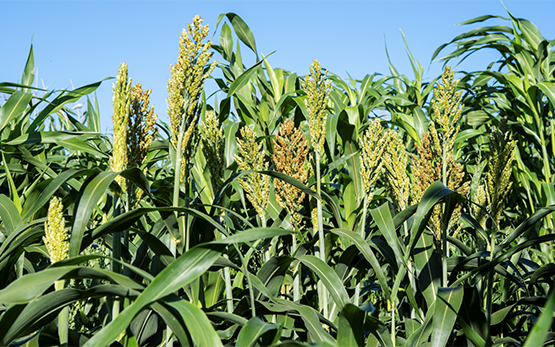The United Nations has declared 2023 the ‘International Year of Millets’. Millets have advantages over other cereal species and forage plants: they are undemanding, drought-resistant, rich in minerals and gluten-free. For several years now, Agroscope has been researching the millet species sorghum, among others.

Sorghum millet – to name just one of the many agriculturally utilisable millets – has the potential to contribute to a sustainable, site-adapted agricultural and food sector. That’s why the United Nations has declared 2023 the ‘International Year of Millets’. Recently, experts from seven Agroscope research groups and from partner organisations Grangeneuve, Agridea and Prometerre met with private parties who work with sorghum for knowledge exchange. For several years now, sorghum has been attracting more and more attention – not just in Switzerland, but worldwide. The reason for this is that millets get by with less water than many other crops, and are thus better able to withstand the droughts that are occurring increasingly often.
From forage production to cheesemaking
In this exchange, results from various projects on the cultivation and use of sorghum as a forage plant and as a raw material for food production were presented. Important topics were the variety traits, use intensity (single and multiple-cut), the use of sorghum in fodder-production mixtures with legumes, its use as an oversowing south of the Alps, and the pros and cons of sorghum as a feed crop in terms of its prussic acid-forming elements.
With regard to the influence of sorghum on the quality of foods, results among others from cheese production were presented. In a joint Agroscope-Grangeneuve project, experts examined the quality of Gruyère made from the milk of cows that grazed on either sorghum or grass. This study demonstrated that as a forage plant for dairy cows, sorghum does not have a negative effect on either the cheese-making process or on the quality of the end product.
The interest of practitioners in cultivating this as-yet-niche crop is also attracting the attention of the agricultural extension service, which is seeking to acquire more information and is interested in applied and interorganisational projects.
Silage sorghum suitable for almost all arable-crop regions of Switzerland
At present, the area devoted to sorghum cultivation in Switzerland is still low. With a view to the possible expansion of sorghum growing, Agroscope has already investigated an important factor: the climatic conditions here in Switzerland. The aim here was to discover which arable-crop-growing areas of Switzerland are suitable for the cultivation of silage or grain sorghum. Temperature maps show that the thermal requirements for growing silage sorghum on almost all arable land in Switzerland are already being met today. The cultivation of grain sorghum, however, is limited to selected areas in low-lying regions along the Lake Geneva – Lake Constance axis as well as in the Valais, the Rhine Valley and south of the Alps. With the development of thermal suitability maps for silage and grain sorghum in Switzerland, a major information gap is being bridged. You can read more on this subject in Swiss Agricultural Research.
Contact
Link
Further Information
Last modification 19.04.2023







